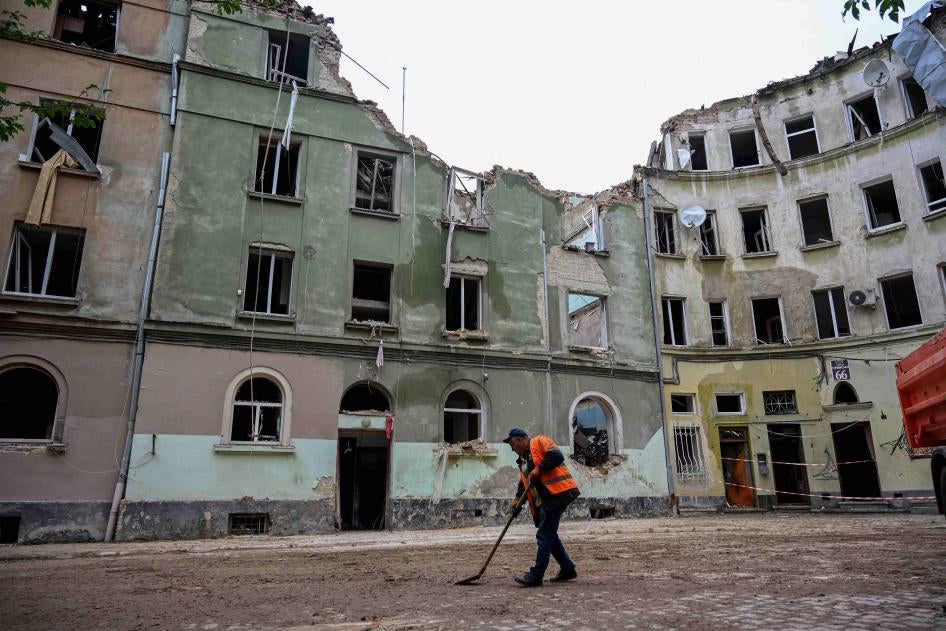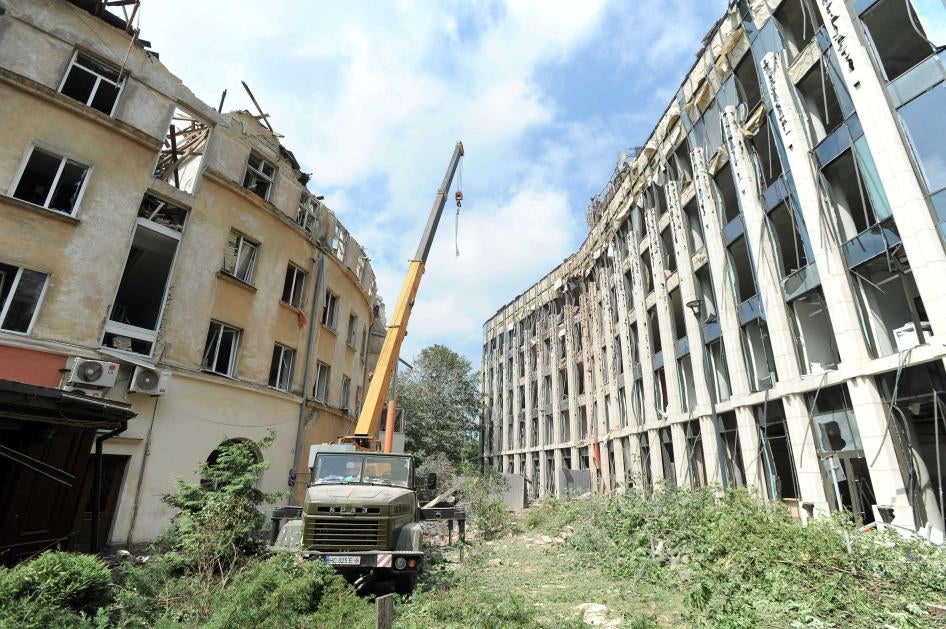(Kyiv, July 19, 2023) – A Russian cruise missile strike on Lviv in western Ukraine on July 6, 2023, struck a residential apartment complex in violation of the laws of war, Human Rights Watch said today. Although Ukrainian military targets were in the vicinity, the strike by a guided munition with a large, high-explosive warhead on an apartment complex in a residential area should be investigated as a possible war crime. The Lviv city council administration told Human Rights Watch that the attack killed 10 civilians and injured 48, ages 20 to 74.
The Ukrainian Armed Forces general staff said in a July 7 statement that Russian forces attacked Lviv early in the morning of July 6 with 10 Kalibr cruise missiles, 7 of which were shot down. Residents reported hearing three explosions. One missile hit a residential complex 270 meters from one military target and 290 meters from another Ukrainian military objective. A Russian Foreign Ministry spokesperson claimed that in carrying out the July 6 attack, Russian forces “hit only legitimate military targets,” but made no reference to the apartment complex or the civilian casualties.
“Russian forces used cruise missiles in their July 6 attack on Lviv and unlawfully struck a large apartment complex filled with sleeping civilians in violation of the laws of war,” said Yulia Gorbunova, senior Ukraine researcher at Human Rights Watch. “Targeting Ukrainian military objectives in the city doesn’t give Russia free rein to attack civilian buildings.”
Between July 8 and 17, Human Rights Watch interviewed representatives of local authorities, military officials, and rescue workers, and spoke to 22 Lviv residents, including people who lived in the apartment complex that was directly hit and in neighborhood buildings. Human Rights Watch also analyzed 29 videos and 232 photographs taken during the attack or in its immediate aftermath, and reviewed satellite imagery to corroborate the scale of the damage. Human Rights Watch concluded that the other two missiles most likely struck a military target and that blast waves caused by detonations damaged many neighborhood residential buildings.
On July 10, Lviv administration officials said that the attack damaged at least 35 buildings, including the roofs of 18 residential buildings, 4 irreparably.
Human Rights Watch visited the large residential complex on the corner of Akademika Sakharova and Stryiska Streets that was the site of one strike and viewed damage to the building. Local residents said that about 500 people lived in the trapezoid-shaped residential complex. Human Rights Watch also observed the damage to nine other neighborhood apartment buildings, many of which had significant visible damage to roofs and facades. Dozens of cars parked nearby were also damaged.
Human Rights Watch was unable to visit the sites of the other two strikes, but concluded, based on satellite imagery, that the damage to the neighborhood buildings was most likely caused by blast waves from the detonation of all three missiles.
Tetiana, who lived in the residential complex at Stryiska Street 70 and who declined to share her last name, said that she was at home in her second-floor apartment with her sister when they heard an explosion at around 2:45 a.m., followed by another explosion fifteen minutes later. “I was looking out the window, facing the park,” Tetiana said. “And I saw a rocket flying from the direction of the park. It looked like a bolt of lightning. It was very bright.”
Nataliya Sokyrchuk, 36, who lives on the fourth floor at Stryiska Street 66, one of the most severely damaged parts of the residential complex, said that the air raid siren woke her up at around 2 a.m. She took shelter in the bathroom with her husband, 43, and their 8-year-old son. A short time later they heard a whistling sound and the sound of an explosion that blew out windows in their living room. The family then ran to the basement. After that, she said, she heard two more explosions, each accompanied by a rumbling sound.
Ihor Ivanov, 34, lives on the first floor of Striyska Street 68, his apartment windows facing the yard. He also said that that he heard three explosions starting at 2:30 a.m. and that there were about 15 minutes between the first and the second explosions. He said that the second explosion hit his building. “I looked at the room and it was destroyed. There was glass on the floor and my legs were pinned down by a broken window frame. I saw blood on myself, broken glass and dust all around.”
Sokyrchuk said that her neighbor Olha Dudka, 65, was killed in the attack. “She didn’t usually go down to a shelter,” Sokyrchuk said. “After it all happened, I called her, hoping that she got out or maybe she wasn’t home. Or maybe that she was [only] injured. I tried calling but she didn’t pick up.” Several hours later, a rescue worker phoned Sokyrchuk to inquire about the floor plans for her apartment and her next door neighbor’s and told her that Dudka had been killed in the attack.
Oleksandr, 38, who lives on the top floor of a five-story apartment building approximately 400 meters from the most damaged part of the apartment complex, said that he was at home with his wife and two children, 8 and 11, when he heard the air raid siren at around 2 a.m.
He said that the window in his bedroom was open and that approximately an hour later, he heard a “tremendous rumble, like the sound of a jet plane,” immediately followed by an explosion. The explosion blew out windows in his apartment, along with some window frames. He and his wife rushed to the corridor where their children were already sheltering, then heard another explosion, a couple of minutes after the first one. The lights in the apartment went out. He said they heard a third explosion about 10 minutes after the second one, as they drove away in their car from the building.
Oleksandr said his building was not hit directly, but that a blast wave blew out all of its windows and damaged the roof and about 20 cars parked outside. Human Rights Watch verified 10 photographs and 6 videos showing damage, consistent with Oleksandr’s testimony, to both the interior and exterior of the building. Satellite imagery showed that the blast wave from the strikes that hit a military target nearby most likely caused damage to apartment buildings that were less than 100 meters away from the target, including Oleksandr’s.
A local resident who said that they were aware of a nearby Ukrainian military facility, had seen Ukrainian military vehicles, heavy military equipment, and military personnel in the vicinity.
In a video message posted on his social media account, the Lviv mayor, Andriy Sadovyi, said the July 6 strikes were the largest attacks on civilian buildings in Lviv since the beginning of Russia’s full-scale invasion in February 2022.
The damage to the apartment complex was consistent with the effects of an explosive weapon of the size and explosive content of a Russian Kalibr-series missile, Human Rights Watch said. Kalibr-series cruise missiles are capable of accurately delivering a 400 to 500 kilogram high explosive blast warhead to targets at long distances. This modern weapon is guided to the target by active radar, digital terrain-matching, and satellite navigation (GLONASS) systems.
The laws of war applicable to the international armed conflict in Ukraine prohibit deliberate attacks on civilians and civilian structures, and attacks that do not discriminate between combatants and civilians, which include attacks not directed at a specific military objective. Bombardments that treat a number of clearly separated and distinct military objectives in a city or town containing civilians and civilian objects as a single military objective are also indiscriminate attacks.
Ukraine is obligated, to the extent feasible, to avoid locating military objectives within or near densely populated areas. Russian forces are nonetheless still required to take all feasible precautions to avoid loss of civilian life and damage to civilian objects.
“Russian forces’ use of guided munitions that can be targeted at specific military objectives increases the possibility that the unlawfully indiscriminate attack on the apartment complex was deliberate,” Gorbunova said. “This and similar attacks need to be investigated.”








